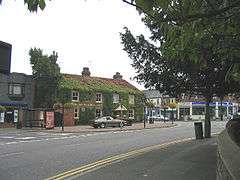Stanford-le-Hope
| Stanford-le-Hope | |
 |
|
 Stanford-le-Hope |
|
| Population | 28,765 (2011)[1] |
|---|---|
| OS grid reference | TQ683822 |
| Unitary authority | Thurrock |
| Ceremonial county | Essex |
| Region | East |
| Country | England |
| Sovereign state | United Kingdom |
| Post town | STANFORD-LE-HOPE |
| Postcode district | SS17 |
| Dialling code | 01375 |
| Police | Essex |
| Fire | Essex |
| Ambulance | East of England |
| EU Parliament | East of England |
| UK Parliament | South Basildon and East Thurrock |
Coordinates: 51°30′50″N 0°25′28″E / 51.5140°N 0.4244°E
Stanford-le-Hope is a town and Church of England parish situated in the county of Essex, England. The town is within the unitary authority of Thurrock and located 23.8 miles (38.4 km) east of Charing Cross in London. Its principal claim to fame is that Joseph Conrad lived and wrote there. Unlike some other areas of Thurrock, Stanford-le-Hope is surrounded by countryside and farmland. The town is served by Stanford-le-Hope railway station.
Often known locally simply as Stanford, the town is home to many commuters working in London, thanks to its proximity to the capital and its c2c-operated London, Tilbury and Southend Railway rail connections. Until recently the town benefited from two refineries located on the nearby Thames, Shell Haven and Coryton. Both have now closed, the Shell site ceased operating in 1999 and has now been redeveloped by Dubai Ports as a deepwater container port with attendant logistics and commercial development. Coryton refinery ceased to operate in 2013, demolition of the process units continues and the site is now under redevelopment as a Fuels Storage and Distribution Terminal in a joint venture between Greenergy and Shell as well as an enterprise zone. Both these changes point to a bright future for the town. Many residents also travel along the nearby A13 to work in the Lakeside Shopping Centre, as well as the industrial and commercial businesses along the north bank of the Thames running west towards the Port of London.
As Stanford-le-Hope grows in size, it has started to incorporate neighbouring settlements such as Corringham, Mucking and Fobbing, the latter of which was the scene of one of the uprisings which led to the Peasants' Revolt.
Stanford-le-Hope is bordered to the north by the A13 road and to the south by the Thames Estuary. It is located 12.7 miles (20.5 km) west of Southend-on-Sea. The town centre has a village feel with its 800-year-old church, St Margarets making a prominent and attractive landmark around which shops, pubs and restaurants have grown to create a lively core to the town.
The River Hope, a tributary of the Thames runs through the town.[2]
Locally there are a number of parks and nature reserves, notably Thurrock Thameside Nature Reserve, with a visitor centre providing views up and down the Thames across both industrial and natural landscapes including the Mucking Flats SSSI.
The result of the Thurrock Council 2016 local elections meant that Stanford-le-Hope was represented by six councillors from the Conservative Party, and two UKIP councillors.
References
- ↑ "Town population 2011". City Population. Retrieved 6 September 2016.
- ↑ Walker, John (1810). The Universal Gazetteer.
Hope, a small river of Essex which ... waters Stanford le Hope
External links
![]() Media related to Stanford-le-Hope at Wikimedia Commons
Media related to Stanford-le-Hope at Wikimedia Commons